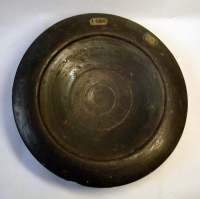



amphora
An item at Louvre
Decoration: on collar; palmette and lotus flower (chain, double) on shoulder; tongues on belly (side A); departure in chariot; left (under handle); young man (chiton, himation, holding, lance, seated, on seat, behind); hoplite (helmet, beard, chiton, short, holding, lance, 2, shield, near); charioteer (headband, xystis, shield, holding, goad, driving); quadriga (horse, 4, harness); right; hoplite (helmet, himation, greaves, holding, shield, in front); woman (chiton, himation); in the background; hoplite (remains, helmet) on belly (side B); departure of warrior (?); man (2, remains, 1, chiton, himation, holding, lance, on either side of); young man (2, remains, 1, headband, naked, holding, lance, on either side of); man (remains, draped, near); horse (remains, harness) on belly (at the bottom); lotus flower and bud (frieze); radiating edges Condition of the work: incomplete; less the handle A_B and half of the mouthpiece redone in plaster; gaps (center of side A, foot, side B) completed in plaster; reattached; chips (mouthpiece, foot, handle); white highlights erased (details and episemas of the shields, xystis of the charioteer, flesh of the woman, beard and hair of the man on the left side B) Restoration: restoration (1986, Ifroa)-remade (mouthpiece, handle)-completed-reattached
Department of Greek, Etruscan and Roman Antiquities
An exhibit at Louvre
The Department of Greek, Etruscan, and Roman Antiquities is home to a collection of artworks representing the Greek, Etruscan, and Roman civilizations; it illustrates the art of a vast area encompassing Greece, Italy, and the whole of the Mediterranean basin, and spans the period from Neolithic times (4th millennium BC) to the 6th century AD.




